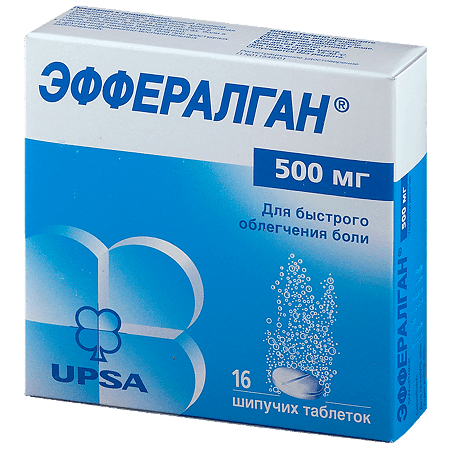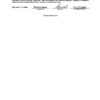No products in the cart.
Efferalgan, 500 mg 16 pcs
€5.86 €5.21
Description
Paracetamol has analgesic, antipyretic and very weak anti-inflammatory effects due to its effect on the thermoregulation center in the hypothalamus and a weak ability to inhibit the synthesis of prostaglandins in peripheral tissues.
The drug has no negative effect on water-salt metabolism (retention of sodium and water) and mucous coat of gastrointestinal tract due to no effect on the synthesis of prostaglandins in peripheral tissues.
Indications
Indications
Active ingredient
Active ingredient
Composition
Composition
1 tablet contains:
Active ingredients:
paracetamol – 500 mg
Excipients:
citric acid anhydrous,
sodium carbonate anhydrous,
sodium bicarbonate,
sorbitol,
soluble saccharin,
sodium docusate,
povidone,
sodium benzoate.
How to take, the dosage
How to take, the dosage
The drug is taken orally. The tablet should be dissolved in a glass of water (200 ml). Do not chew or swallow the tablets.
In general, 1-2 tablets are used. 2-3 times a day at intervals of at least 4 hours.
The maximum single dose is 2 tablets (1 g), the maximum daily dose is 8 tablets (4 g), which corresponds to a single dose of 10-15 mg/kg body weight and a maximum daily dose of 75 mg/kg body weight.
As a rule it is not necessary to exceed the recommended daily dose of paracetamol of 3 g. The daily dose may be increased to the maximum (4 g) only in case of severe pain.
In patients with impaired renal function, the time interval between doses should be at least 8 hours if CK is less than 10 ml/min, and at least 6 hours if CK is 10-50 ml/min.
In patients with chronic or compensated active liver disease, especially those with hepatic insufficiency, in patients with chronic alcoholism, chronic malnutrition (insufficient glutathione reserve in liver), Gilbert syndrome (hereditary hyperbilirubinemia), dehydration or body weight less than 50 kg the drug dose should be decreased or interval between doses should be increased. The daily dose should not exceed 2 g, i.e. 4 tablets.
The drug should be used with caution in children and patients weighing less than 50 kg to avoid the risk of exceeding the recommended dose.
The dosing regimen in children over 12 years of age and weighing more than 43 kg is the same as in adults, with an interval of preferably 6 hours (strictly at least 4 hours).
The duration of use without consulting a physician is not more than 5 days when prescribed as a pain reliever and 3 days as a fever reliever.
Interaction
Interaction
Inducers of microsomal liver enzymes or potentially hepatotoxic substances (e.g. ethanol, rifampicin, isoniazid, hypnotics and antiepileptics including phenobarbital, phenytoin and carbamazepine) increase paracetamol toxicity and may lead to liver damage even with non-toxic doses of paracetamol, so liver function should be monitored.
Phenytoin decreases the effectiveness of paracetamol and increases the risk of hepatotoxicity; therefore, patients taking phenytoin should avoid frequent use of paracetamol, especially in high doses.
Paracetamol reduces the effectiveness of uricosuric drugs.
Paracetamol may increase the risk of increasing the concentration of chloramphenicol and as a consequence, the risk of neutropenia may increase, and hematologic parameters should be controlled. The simultaneous use of these two drugs is possible only after consultation with a physician.
Probenecid decreases clearance of paracetamol by almost 2-fold, which requires reducing the dose of paracetamol.
Multiple administration of paracetamol for more than 4 days increases the anticoagulant effect. International normalized ratio (INR) should be monitored during and after the termination of concomitant use of paracetamol (especially in high doses and/or for a long time) and coumarin derivatives. If necessary, adjust the dose of anticoagulants. Occasional use of paracetamol has no significant effect on the effect of anticoagulants.
Propantelin and other drugs that slow the evacuation from the stomach decrease the rate of absorption of paracetamol, which may delay or reduce the onset of effect.
Methoclopramide and domperidone increase the rate of absorption of paracetamol and therefore the onset of analgesic and antipyretic effects.
Long-term use of barbiturates reduces the effectiveness of paracetamol.
Ethanol promotes acute pancreatitis.
Long-term co-use of paracetamol and other NSAIDs increases the risk of analgesic nephropathy and renal failure.
The simultaneous long-term use of high-dose paracetamol and salicylates increases the risk of developing kidney or bladder cancer.
Diflunisal increases the plasma concentration of paracetamol by 50% – risk of hepatotoxicity.
Myelotoxic drugs increase the manifestations of hematotoxicity of the drug.
Salicylamide may increase the T1/2 of paracetamol.
Special Instructions
Special Instructions
In order to avoid overdose, the content of paracetamol in other drugs taken by the patient simultaneously with the drug Efferalgan ® should be taken into account. Taking paracetamol in doses higher than recommended may cause severe liver damage.
In case of continued febrile syndrome with paracetamol use for more than 3 days, and pain syndrome for more than 5 days, a physician’s consultation is required.
The use of Efferalgan ® may interfere with the laboratory tests for quantitative determination of glucose and uric acid in plasma.
In order to avoid toxic liver damage, paracetamol should not be combined with the intake of alcoholic beverages and should not be taken by persons prone to chronic alcohol consumption.
The risk of liver damage increases in patients with alcoholic hepatosis. In patients with nutritional deficiencies (low liver glutathione reserve) paracetamol should be used with caution, reducing the daily dose and/or increasing the interval between doses.
Long-term use of the drug requires monitoring of peripheral blood count and liver function.
Paracetamol may cause serious skin reactions such as Stevens-Johnson syndrome, toxic epidermal necrolysis, acute generalized exanthematous pustulosis, which may be fatal. At the first manifestation of rash or other hypersensitivity reactions, the use of the drug should be discontinued.
Paracetamol use should be discontinued if acute viral hepatitis is detected in a patient.
The drug Efferalgan® contains 412.4 mg of sodium per tablet, which must be taken into account by patients who are on a strict low-salt diet.
Because the drug contains sorbitol, it should not be used in patients with sucrose/isomaltase deficiency, fructose intolerance, or glucose-galactose malabsorption.
If paracetamol is used in the recommended dose range, no effect on concentration and speed of psychomotor reactions has been found. If the patient experiences dizziness, psychomotor agitation and disorientation in space and time, it is not recommended to drive vehicles and other mechanisms during treatment with the drug.
Contraindications
Contraindications
With caution: Severe renal failure (CK <30 ml/min), hepatic failure, chronic alcoholism, anorexia, bulimia, cachexia, hypovolemia, dehydration, glucose-6-phosphate dehydrogenase deficiency, congenital hyperbilirubinemia (Gilbert, Dubinin-Johnson and Rotor syndrome), viral hepatitis, advanced age.
Side effects
Side effects
The following side effects have been reported with the use of the drug (frequency has not been established).
Allergic reactions: hypersensitivity reactions, skin itching, skin and mucous membrane rash (erythema or urticaria), Quincke’s edema, erythema multiforme (including Stevens-Johnson syndrome), toxic epidermal necrolysis (Lyell syndrome), anaphylactic shock, acute generalized exanthema pustulosis.
Respiratory system: bronchospasm.
Nervous system disorders (in high doses): dizziness, psychomotor agitation and disorientation in space and time.
Digestive system disorders: nausea, diarrhea, epigastric pain, increased liver enzyme activity, usually without development of jaundice, hepatonecrosis (dose-dependent effect), hepatitis, tenesmus, liver failure.
Renal and urinary tract disorders: increase in creatinine.
Endocrine system disorders: hypoglycemia, up to hypoglycemic coma.
Hematopoietic system disorders: anemia (cyanosis), sulfohaemoglobinemia, methemoglobinemia (shortness of breath, heart pain), hemolytic anemia (especially in patients with glucose-6-phosphate dehydrogenase deficiency), thrombocytopenia, neutropenia, leukopenia.
Others: decreased BP (as a symptom of anaphylaxis), changes in prothrombin time and international normalized ratio (INR).
Overdose
Overdose
In overdose intoxication is possible, especially in children, patients with liver disease (caused by chronic alcoholism), in patients with nutritional disorders, as well as in patients taking enzyme inducers, in which lightning hepatitis, liver failure, cholestatic hepatitis, cytolytic hepatitis may develop, in the above cases – sometimes with fatal outcome. The clinical picture of acute overdose develops within 24 hours after taking paracetamol.
Symptoms:
Gastrointestinal distress (nausea, vomiting, decreased appetite, abdominal discomfort and/or abdominal pain), pale skin, sweating, malaise. When administered to adults 7.5 g or more or children more than 140 mg/kg at a time, cytolysis of hepatocytes occurs with complete and irreversible liver necrosis, development of liver failure, metabolic acidosis and encephalopathy, which may lead to coma and death.
12-48 hours after administration of paracetamol an increase in liver transaminase activity, lactate dehydrogenase, bilirubin concentration and decrease in prothrombin concentration is noted. Clinical symptoms of liver damage appear 1-2 days after overdose of the drug and reach their maximum on the 3rd-4th day.
Treatment:
Immediate hospitalization; quantification of plasma paracetamol before treatment as soon as possible after overdose; gastric lavage; administration of SH-group donors and precursors of glutathione synthesis – methionine and acetylcysteine – within 8 h after overdose.
The need for additional therapeutic measures (further administration of methionine, intravenous administration of acetylcysteine) is determined depending on the concentration of paracetamol in blood, as well as on the time elapsed after its administration; symptomatic treatment; liver tests should be performed at the beginning of treatment and then – every 24 hours. In most cases, liver transaminase activity normalizes within 1-2 weeks. Liver transplantation may be required in very severe cases.
Pregnancy use
Pregnancy use
The drug is contraindicated in I and III trimesters of pregnancy and during lactation (breast-feeding).
Similarities
Similarities
Additional information
| Shelf life | 3 years. |
|---|---|
| Conditions of storage | Store out of the reach of children at temperatures under 30 ° C. |
| Manufacturer | UTSA SAS, France |
| Medication form | effervescent tablets |
| Brand | UTSA SAS |
Related products
Buy Efferalgan, 500 mg 16 pcs with delivery to USA, UK, Europe and over 120 other countries.






















